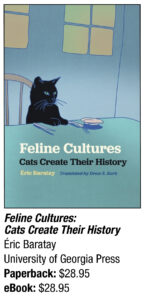
Through this book, Baratay observes the animal’s perspective to document how individual cats have carried out their lives. He seeks to understand what cats have felt and experienced by writing from the perspective of the animals. Cats show a great plasticity of behavior, whether they be street cats, farm cats, pet cats, companion cats or “catdogs.” This book establishes that cats have their own cultures, adaptations and history.
Baratay pays attention to cats’ perceptions of the world, their sensations and their emotions, their sensitivity and character, their bodily expressiveness, and their interactions with the environment, other animals and humans. With Baratay’s observations and words, ethology becomes an ethnology.